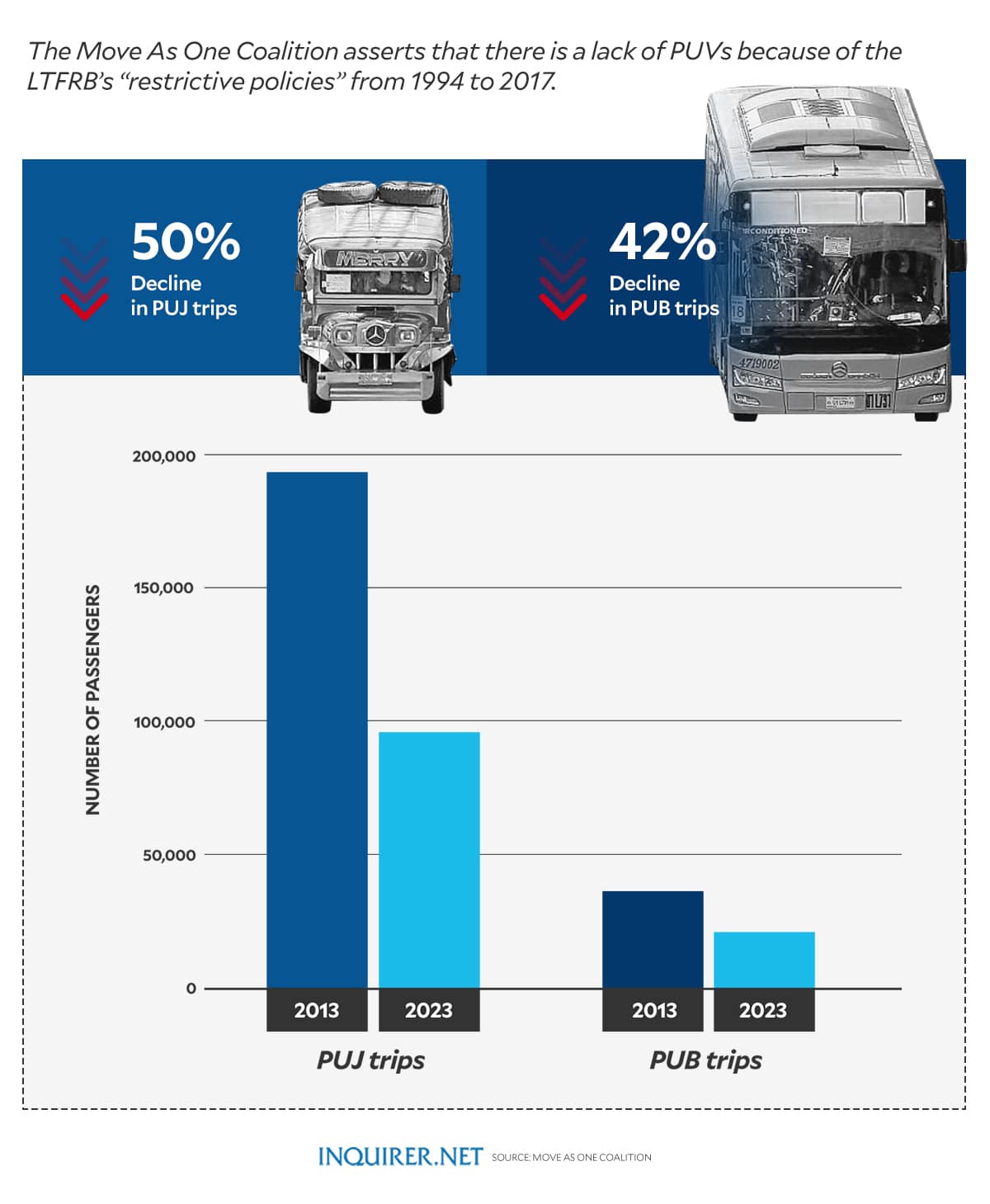
PUV composite image from Inquirer files
Overloading is not a problem but a symptom of a persistent and serious crisis.
This was pointed out by the Move As One Coalition as the Land Transportation Franchising and Regulatory Board (LTFRB) and Land Transportation Office (LTO) bared its plan to impose stiffer penalties for overloading.
As the LTFRB said last week, overloading PUVs will be penalized with P5,000 fine and suspension or cancellation of certificates of public convenience, stressing that it already outlined the passenger limit.
Traditional and modern jeepneys, referred to as PUJ, are allowed to carry 12 to 32 passengers, depending on the design and specifications set by the manufacturer. Modern PUJs can have a maximum of five standing passengers.


GRAPHIC: Ed Lustan/INQUIRER.net
Buses, or PUBs, may carry 50 or more passengers, while regular and extended vans are allowed to have 10 and 12 passengers, respectively. Eight are allowed on a UV Express.
RELATED STORY: LTFRB: No overloading, overcharging, or operating ‘colorum’ vehicles
The coalition, however, stated that “such punitive measures will only add to the hardships of commuters and PUV operators, and even worsen PUV overloading, which may put commuter safety at risk.”
READ: As PH transport crisis worsens, workers say traffic, lack of rides are draining them
It asserted that the proposal of the LTFRB and LTO is “misguided and ill-conceived, as it fails to address the root cause of PUV overloading, [which is] the chronic undersupply of PUVs, which has resulted from LTFRB’s own restrictive policies from 1994 to 2017.”
Highlighting what Dr. Victor Limlingan, a retired professor at the Asian Institute of Management, said in a column, the coalition pointed out the four LTFRB policies that led to the undersupply of PUVs.
There was one in 1994, which was the PUJ and PUV franchise moratorium in Metro Manila. There was also an inter-regional PUJ franchise moratorium in 2001 and a nationwide moratorium on issuance of franchise for all types of services in 2003.
The last one, it said, was in 2017, when franchises were issued based on the LTPRP, or the Local Public Transportation Route Plan, which is a result of the PUV Modernization Program.
RELATED STORY: PUV modernization: Filipino jeepneys out, China imports in
It said these led to an overwhelming decline in the service provided by PUVs, especially PUJs and PUBs, pointing out that “the government’s denial will only deepen this worsening crisis.”
The coalition stressed that the millions of workers, students, elderly and persons with disabilities who are forced to wait in long lines and squeeze into overcrowded PUVs to get to work or school are not isolated rush hour incidents.
READ: PUV modernization: Understanding defiance of operators, drivers
“They are daily symptoms of a systemic shortage in public transport supply.”


GRAPHIC: Ed Lustan/INQUIRER.net
Based on data from the Metro Manila Development Authority and the Department of Transportation (DOTr), vehicle presence in Metro Manila rose by 43 percent from 2.54 million in 2013 to 3.63 million in 2023.
However, the presence of PUBs declined by 42.3 percent from 36,551 to 21,107, while PUJs registered the highest drop of 50.5 percent, falling from 193,221 in 2013 to 95,659 in 2023.
Motorcycle presence rose by 286.5 percent from 433,340 to 1.67 million.
For the Move As One Coalition, “the issuance of franchises should […] be determined by the number of public vehicles needed to meet the public demand for transport.”
“If the LTFRB’s own policies effectively halted the growth of transport supply — while the population and commuter demand continued to rise — the question must be asked: “How were people expected to get to where they need to go,” it said.
RELATED STORY: 100% DOTr budget hike for 2024 leaves out cyclists, pedestrians, commuters
As pointed out by the coalition, in the absence of sufficient and formal public transport options, commuters must have been left with little choice but to cram into overcrowded vehicles or resort to informal, unregulated modes of transportation.”
“The resulting overloading is not a product of operators’ own motivations, but of a transport system starved of capacity by policy,” it said in a statement released last week.
Based on data from Commuters 4 Change, from 12.46million in 2017, population in Metro Manila already rose to 14.94 million in 2024, but the number of PUJs, PUBs, and UV Express fell to 181.637 from 258,930.
READ: PH transport crisis: Complex problem requiring comprehensive solutions
A 2022 survey by the Social Weather Stations revealed that 94 percent of Filipinos in Metro Manila do not own a car.
The coalition said it is baffled by LTFRB’s statement that “it is now studying if there is a lack of public transportation causing PUVs to be overloaded or if it just happens during rush hours.”
It is asking the LTFRB and the DOTr to immediately review and lift outdated moratoriums on franchise issuance for high-demand routes and update demand estimates using actual commuter data to guide franchise decisions.
For the Move As One Coalition, the government should as well speed up service contracting and other supply-side reforms to increase the supply of safe and dignified public transport.
A system of genuine consultation with all relevant stakeholders, especially public transport workers and commuters of all ages and abilities, should be institutionalized, too, it said.
Great Job & the Team @ INQUIRER.net Source link for sharing this story.





